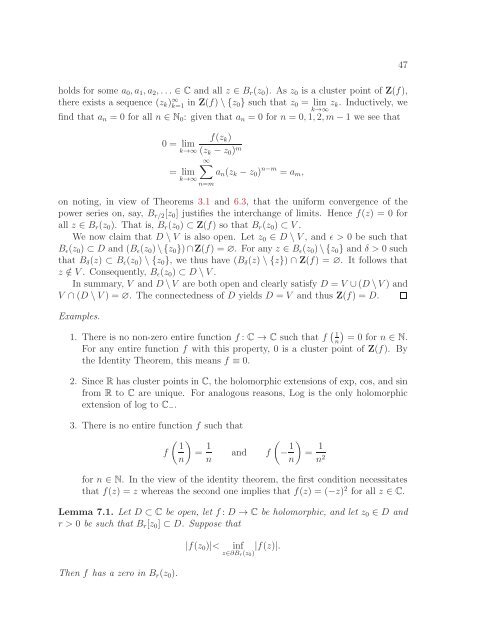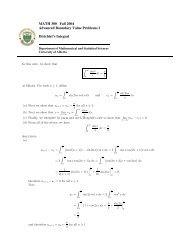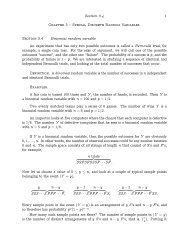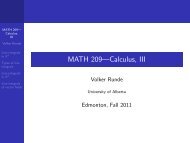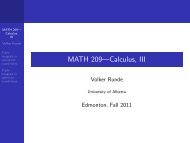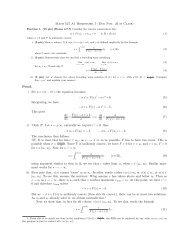Math 411: Honours Complex Variables - University of Alberta
Math 411: Honours Complex Variables - University of Alberta
Math 411: Honours Complex Variables - University of Alberta
You also want an ePaper? Increase the reach of your titles
YUMPU automatically turns print PDFs into web optimized ePapers that Google loves.
holds for some a0,a1,a2,... ∈ C and all z ∈ Br(z0). As z0 is a cluster point <strong>of</strong> Z(f),<br />
there exists a sequence (zk) ∞ k=1 in Z(f)\{z0} such that z0 = lim zk. Inductively, we<br />
k→∞<br />
find that an = 0 for all n ∈ N0: given that an = 0 for n = 0,1,2,m−1 we see that<br />
f(zk)<br />
0 = lim<br />
k→∞ (zk −z0) m<br />
∞�<br />
= lim an(zk −z0) n−m = am,<br />
k→∞<br />
n=m<br />
on noting, in view <strong>of</strong> Theorems 3.1 and 6.3, that the uniform convergence <strong>of</strong> the<br />
power series on, say, Br/2[z0] justifies the interchange <strong>of</strong> limits. Hence f(z) = 0 for<br />
all z ∈ Br(z0). That is, Br(z0) ⊂ Z(f) so that Br(z0) ⊂ V.<br />
We now claim that D \V is also open. Let z0 ∈ D \V, and ǫ > 0 be such that<br />
Bǫ(z0) ⊂ D and (Bǫ(z0)\{z0})∩Z(f) = ∅. For any z ∈ Bǫ(z0)\{z0} and δ > 0 such<br />
that Bδ(z) ⊂ Bǫ(z0)\{z0}, we thus have (Bδ(z) \{z}) ∩Z(f) = ∅. It follows that<br />
z /∈ V. Consequently, Bǫ(z0) ⊂ D\V.<br />
In summary, V and D\V are both open and clearly satisfy D = V ∪(D\V) and<br />
V ∩(D \V) = ∅. The connectedness <strong>of</strong> D yields D = V and thus Z(f) = D.<br />
Examples.<br />
1. There is no non-zero entire function f: C → C such that f � �<br />
1 = 0 for n ∈ N.<br />
n<br />
For any entire function f with this property, 0 is a cluster point <strong>of</strong> Z(f). By<br />
the Identity Theorem, this means f ≡ 0.<br />
2. Since R has cluster points in C, the holomorphic extensions <strong>of</strong> exp, cos, and sin<br />
from R to C are unique. For analogous reasons, Log is the only holomorphic<br />
extension <strong>of</strong> log to C−.<br />
3. There is no entire function f such that<br />
� �<br />
1<br />
f =<br />
n<br />
1<br />
n<br />
and<br />
�<br />
f − 1<br />
�<br />
=<br />
n<br />
1<br />
n2 for n ∈ N. In the view <strong>of</strong> the identity theorem, the first condition necessitates<br />
that f(z) = z whereas the second one implies that f(z) = (−z) 2 for all z ∈ C.<br />
Lemma 7.1. Let D ⊂ C be open, let f: D → C be holomorphic, and let z0 ∈ D and<br />
r > 0 be such that Br[z0] ⊂ D. Suppose that<br />
Then f has a zero in Br(z0).<br />
|f(z0)|< inf |f(z)|.<br />
z∈∂Br(z0)<br />
47


